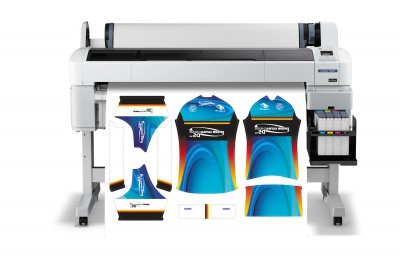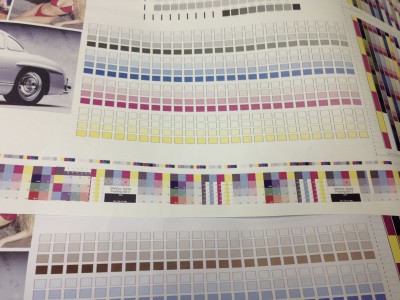
Mainstream printer manufacturers like Epson have now entered the dye sublimation market. Photo courtesy Epson Canada
That said, compared to the apparent ease of direct printing, there are lots of factors to consider when putting together a heat-transfer-based workflow for wide-format printing.
“We’ve researched paper manufacturers worldwide,” said Northup. “There are some high-performance papers, but they all act differently in different printers. So, you’ve got to look at what printer you’re running and then what material you’re sublimating to—e.g. ceramic, fabric or glass—before choosing the right transfer paper and ink.”
“The paper is the single most important factor in colour management,” Eversole agreed. “Clay-coated papers tend to be the most forgiving. Cellulose-based papers cost less and require less ink, but are also less forgiving. And there are different levels of tack. Not every paper will stick to every substrate. You need to try stuff out first, do some of your own research and development (R&D).”
“Our systems print both direct and via transfer, but certainly, the paper’s a very important piece of this business,” said Wozny. “There are big differences in performance.”
Printer support
There are also differences between the printers that can support dye sublimation in a sign shop environment.
“There’s no one answer, as it’s application-based,” said Terramagra. “Some printers are manufactured specifically for dye sublimation, while others are converted. Prices range from a few thousand dollars to more than $100,000. So, beginners will want to make sure they’re working with an experienced dealer to understand all of the options available to them.”
“You want versatility,” said Eversole. “You’re making an investment that needs to earn a return in the next couple of years, but it’s easier to know what you’re doing today than tomorrow. As printers evolve with finer-aperture printheads, for example, some inks can’t fit through and will clog. So, a given ink won’t work with every printer. The printhead has to be compatible with the dye.”
Another factor for success is the raster image processor (RIP), which interprets the graphics’ ‘language’ from the file to the printer.

Gans Ink & Supply’s research suggests transfer papers are the most important element in colour management because “they all act differently in different printers.” Photo courtesy Gans Ink & Supply
“As graphics shops grow, they realize a raster image processor (RIP) is very important,” said Northup. “It’s the big communicator at all levels, including production management and colour management.”
“It’s about the user, not the tool,” said Eversole, “so the RIP also has to be appealing to use.”
For these and other reasons of compatibility between components and for specific graphic applications, the panel discussed the need for additional support.
“Anyone can get a printer up and running, but one of the most common problems is not paying for proper installation and training,” said Northup. “If dye sublimation were easy, everyone would already be doing it! Once they adopt proper colour profiles and preventive maintenance, on the other hand, the difference is like night and day.”
Without such support, there is a tendency for sign-industry professionals—who are more accustomed to printing graphics directly onto vinyl or paper—to find the learning curve very difficult.
“If you don’t have the training and support, you’ll get stuck,” said SGIA’s Burton. “You can end up hitting your head against the wall for the first three to six months.”
With files from SGIA, EFI, Gans Ink & Supply, Axiom America and Mutoh America. For more information, visit www.sgia.org, www.efi.com, www.gansink.com, www.axiomamerica.com and www.mutoh.com.





